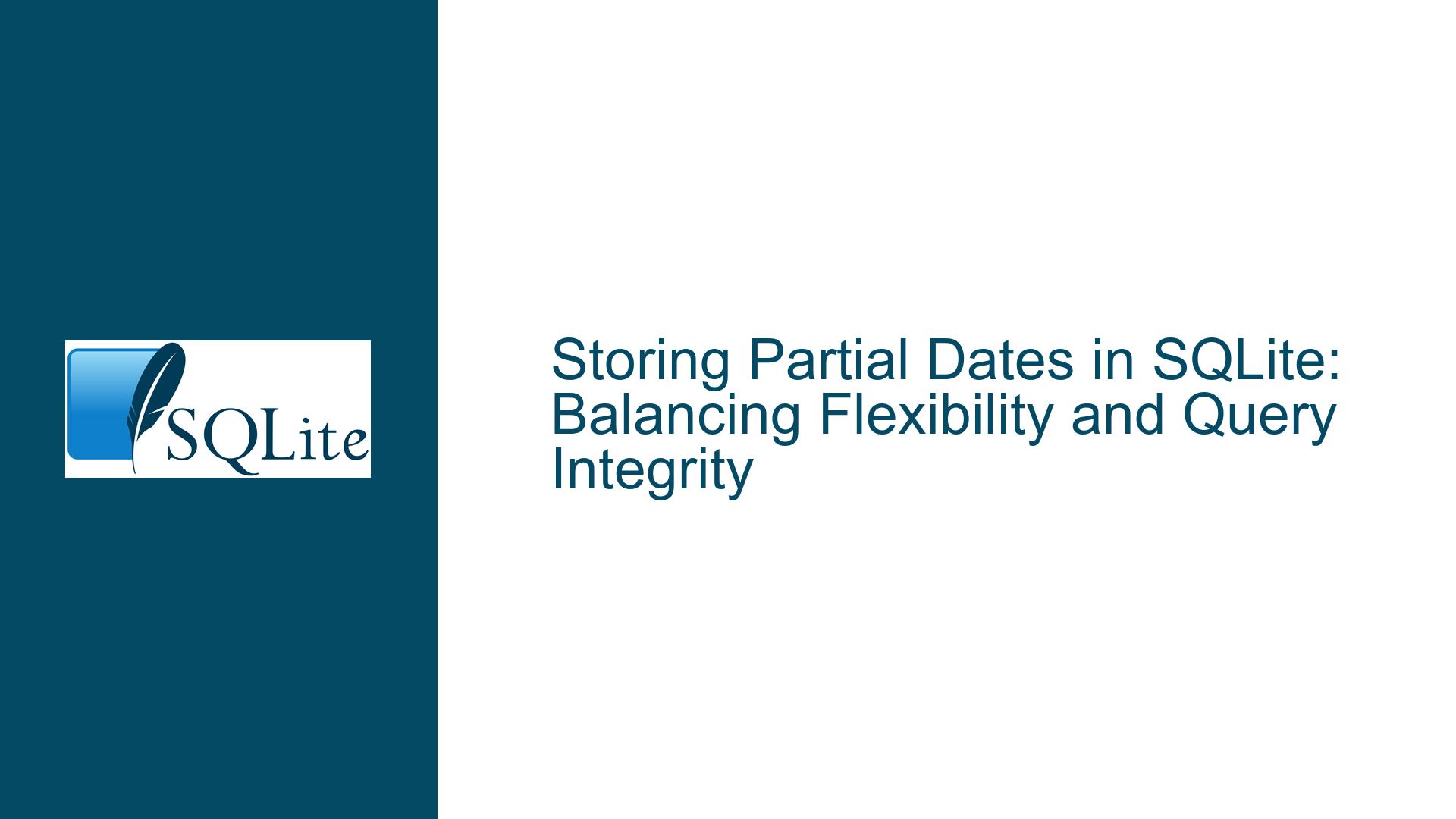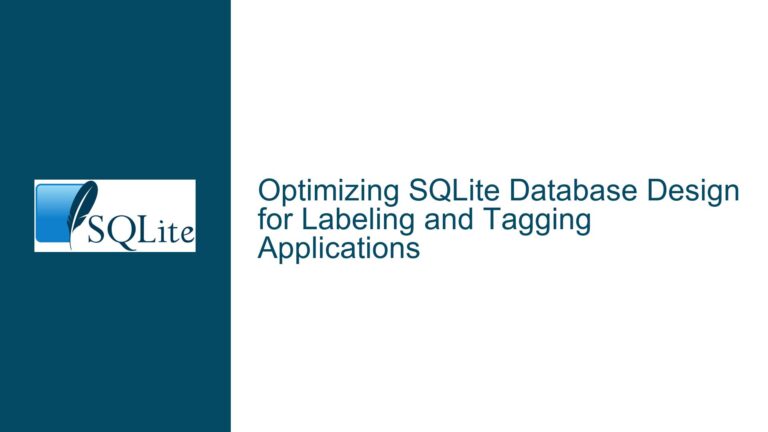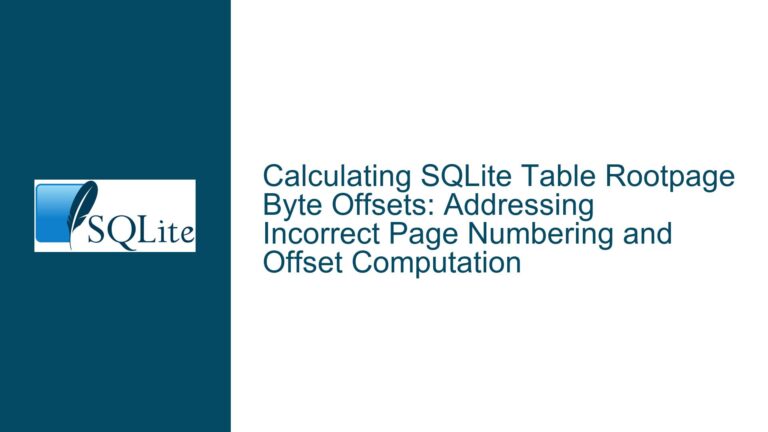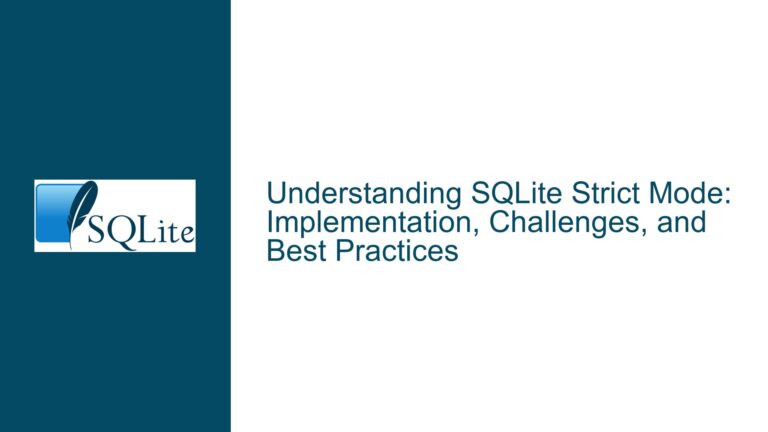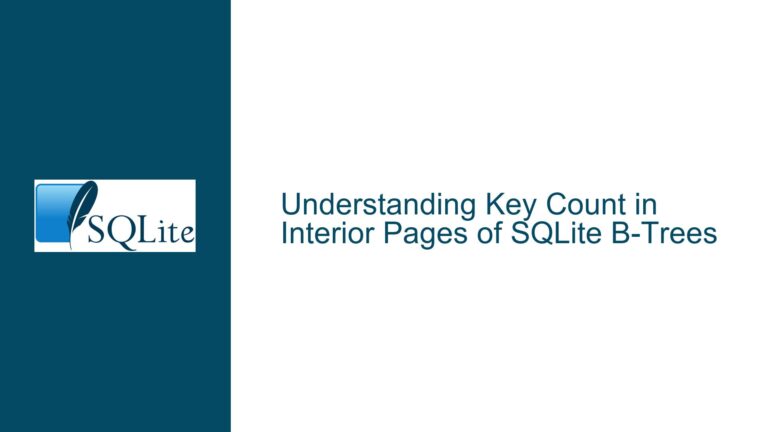Storing Partial Dates in SQLite: Balancing Flexibility and Query Integrity
Understanding Partial Date Storage Requirements and Constraints
The challenge of storing partial dates in SQLite arises when an application must accommodate incomplete temporal information while maintaining the ability to query, sort, and validate dates effectively. Partial dates include scenarios such as:
- Full dates (e.g.,
2021-06-29) - Year-month combinations (e.g.,
2021-06) - Isolated years (e.g.,
2021) - Month-only or day-only values (e.g.,
06,29)
The primary constraint is the requirement to store these variations in a single column without splitting components into separate year, month, and day fields. This limitation often stems from legacy system integration, schema design rigidity, or application-layer data handling requirements. Additional complications include:
- Pre-1970 Dates: Ruling out
INTEGERstorage (Unix epoch time). - Sorting Ambiguity: Ensuring partial dates sort logically relative to complete dates.
- Query Complexity: Extracting components (year/month/day) efficiently.
- Validation: Preventing invalid date representations (e.g.,
2021-13-45).
The ISO-8601 Approach and Its Limitations
The original proposal involved using a TEXT field with ISO-8601-like formatting, where missing components are denoted by trailing dashes:
2021-06-29(complete)2021-06-(year-month)2021--(year-only)-06-(month-only)--29(day-only)
While intuitive, this approach introduces ambiguities:
- Sorting:
2021-06-(June 2021) would sort after2021-06-29(June 29, 2021) lexicographically, which is counterintuitive. - Parsing Overhead: Splitting components requires trimming empty segments.
- Validation Gaps: Without constraints, invalid values like
2021-02-30(February 30) or-13-(invalid month) could be inserted.
Alternative Proposals and Trade-offs
Alternative suggestions in the discussion included:
- Fixed-Length Placeholders: Using a consistent format like
....-06-..for month-only or2021-..-..for year-only. - JSON Storage: Storing components as a JSON object (
{"year":2021,"month":6}). - Separate Columns: Revisiting the constraint against splitting into
year,month, anddaycolumns withNULLallowed.
Each approach has trade-offs:
- Fixed-Length Placeholders: Improves sorting consistency but increases storage overhead.
- JSON: Adds parsing complexity and hinders direct querying of components.
- Separate Columns: Violates the original constraint but offers optimal query performance.
Critical Analysis of Partial Date Storage Pitfalls
Cause 1: Inconsistent Lexicographical Sorting
When partial dates are stored as strings, their lexicographical order may not align with chronological order. For example:
2021-06-(June 2021) vs.2021-06-29(June 29, 2021): The former sorts after the latter because the hyphen following06makes it longer.....-06-..(June) vs.2021-06-29: The placeholder characters (e.g.,.) may sort before or after digits, disrupting chronological order.
Impact: Queries using ORDER BY on date columns will return results in non-chronological order unless the format ensures that shorter partial dates sort before more specific ones.
Cause 2: Ambiguous Component Extraction
Extracting year, month, or day components becomes error-prone if the format does not enforce fixed positions for each component. For example:
- In
2021-06-, the month is at positions 6–7, but in--29, the day is at positions 4–5. - Using variable-length placeholders (e.g.,
-06-) complicates substring operations.
Impact: Application-layer code must handle multiple edge cases, increasing bug risk.
Cause 3: Lack of Validation
Without schema-level constraints, invalid dates can be inserted:
2021-19-45(invalid month and day)-13-(invalid month)....-AB-..(non-numeric month)
Impact: Data corruption and failed queries when attempting date operations.
Cause 4: Storage Inefficiency
Using placeholders like ....-06-.. (10 characters) for month-only storage consumes more space than necessary. While storage overhead is often negligible, it becomes significant at scale.
Robust Solutions for Partial Date Storage and Handling
Solution 1: Standardized Fixed-Length Format with Placeholders
Adopt a fixed-length format using unambiguous placeholder characters. For example:
Complete Date : 2021-06-29 (10 characters)
Year-Month : 2021-06--- (10 characters)
Year-Only : 2021------ (10 characters)
Month-Only : ----06--- (10 characters)
Day-Only : --------29 (10 characters)
- Placeholder Choice: Use
-for missing components to align with ISO-8601 and avoid characters that conflict with SQL operators (e.g.,*,?). - Sorting Fix: Pad partial dates with
-to ensure chronological order.2021-06---sorts before2021-06-29.
Schema Definition:
CREATE TABLE events (
id INTEGER PRIMARY KEY,
partial_date TEXT CHECK(
(length(partial_date) = 10) AND
(substr(partial_date, 1, 4) BETWEEN '0000' AND '9999' OR substr(partial_date, 1, 4) = '----') AND
(substr(partial_date, 6, 2) BETWEEN '01' AND '12' OR substr(partial_date, 6, 2) = '--') AND
(substr(partial_date, 9, 2) BETWEEN '01' AND '31' OR substr(partial_date, 9, 2) = '--')
)
);
Querying Components:
-- Extract year (returns NULL if placeholder)
SELECT
CASE WHEN substr(partial_date, 1, 4) != '----'
THEN substr(partial_date, 1, 4)
ELSE NULL
END AS year
FROM events;
-- Find all events in June
SELECT * FROM events WHERE substr(partial_date, 6, 2) = '06';
Solution 2: Hybrid JSON Storage with Virtual Columns
For applications requiring extreme flexibility, store dates as JSON objects with virtual columns for indexing:
CREATE TABLE events (
id INTEGER PRIMARY KEY,
date_json TEXT CHECK(json_valid(date_json)),
year GENERATED ALWAYS AS (json_extract(date_json, '$.year')),
month GENERATED ALWAYS AS (json_extract(date_json, '$.month')),
day GENERATED ALWAYS AS (json_extract(date_json, '$.day'))
);
Pros:
- Explicit component storage.
- Supports partial dates natively (e.g.,
{"year":2021}).
Cons:
- Overhead from JSON parsing.
- Requires SQLite 3.31.0+ (generated columns).
Solution 3: Epoch Offset for Pre-1970 Dates
If the prohibition against INTEGER storage stems from Unix epoch limitations, use an offset to represent dates before 1970:
-- Store 2021-06-29 as 20210629 (INTEGER)
-- Store 2021-06 as 20210600
-- Store 2021 as 20210000
-- Store 06-29 as 00000629
Pros:
- Integer sorting and comparison work naturally.
- Efficient storage.
Cons:
- Requires application-layer logic to handle offsets.
- Cannot distinguish between
0000(missing year) and year0.
Solution 4: Revisit Separate Column Storage
If constraints allow, use separate nullable columns:
CREATE TABLE events (
id INTEGER PRIMARY KEY,
year INTEGER CHECK(year BETWEEN 0 AND 9999),
month INTEGER CHECK(month BETWEEN 1 AND 12),
day INTEGER CHECK(day BETWEEN 1 AND 31)
);
Pros:
- Optimal query performance.
- Built-in component extraction.
Cons:
- Violates the original single-column requirement.
Implementation Checklist and Best Practices
Choose a Format:
- Prefer fixed-length
TEXTwith-placeholders for balance between sorting and simplicity. - Use
CHECKconstraints to enforce valid components.
- Prefer fixed-length
Indexing Strategy:
- Create indexes on computed components for frequent queries:
CREATE INDEX idx_year ON events (substr(partial_date, 1, 4)); CREATE INDEX idx_month ON events (substr(partial_date, 6, 2));Application-Layer Handling:
- Normalize partial dates during input (e.g., convert
06to----06---). - Use prepared statements to avoid injection when using substring operations.
- Normalize partial dates during input (e.g., convert
Validation Functions:
- Create SQL functions to validate dates:
SELECT partial_date, CASE WHEN date(partial_date) IS NOT NULL THEN 'Valid' ELSE 'Invalid' END AS validity FROM events;Migration Plan:
- For existing data, batch-convert to the new format using
UPDATEstatements withCASElogic.
- For existing data, batch-convert to the new format using
By adhering to these guidelines, developers can implement a partial date storage system in SQLite that balances flexibility, query efficiency, and data integrity.
